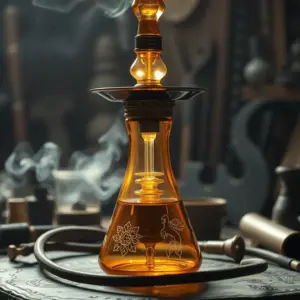> Blogs > The Development of Glass Hookahs: From Tradition to Modern Craft
The Development of Glass Hookahs: From Tradition to Modern Craft
Core keyword: development of glass hookahs
The story of the development of glass hookahs is inseparable from the evolution of culture, craft, and social practice. From their earliest appearances in Middle Eastern courtyards to their modern reinterpretation in international lounges, glass hookahs illustrate how a simple vessel can carry centuries of meaning.
Tracing the Development of Glass Hookahs Across Regions
Early Origins
The earliest hookahs were often fashioned from metal, wood, or even coconut shells, but it was in the Middle East and South Asia that glass became the preferred material. Cairo’s glassblowing workshops, Delhi’s engraving studios, and Ottoman artisans in Istanbul pioneered the use of glass to create vessels that were not only functional but also artistic. This shift elevated the hookah from a tool into a symbol of refinement and hospitality.
Craft Evolution
Over time, the development of glass hookahs mirrored advances in glassmaking itself. Traditional hand-blown pieces carried the character of the artisan, with subtle variations and air bubbles inside the glass. As techniques improved, crystal-like clarity and decorative cutting became more common. Engraved patterns, colored bases, and gilded ornaments appeared, each design reflecting the culture that produced it. The move from purely utilitarian objects to intricate art pieces was gradual but profound.

Regional Adaptations
As hookah culture spread along trade routes, different regions shaped the glass base in unique ways. Middle Eastern styles emphasized geometric motifs and calligraphy, South Asian pieces leaned on vivid colors and ornate decoration, while European versions adopted minimalist elegance during the 19th century café culture boom. In North America and East Asia, modern studios now experiment with sleek proportions, combining durability with a global aesthetic.
Modern Directions
Beyond aesthetics, the development of glass hookahs also reflects social transformation. In many regions, the hookah base has shifted from being a symbol of exclusivity in elite circles to a more widely embraced object of leisure. This transition shows how handmade artistry can adapt to the rhythms of modern society, where younger generations seek experiences that balance tradition with lifestyle. Museums and cultural festivals now frequently showcase historical glass hookahs, emphasizing their role as both functional objects and artistic heritage. Such recognition highlights how these vessels are not only used but also celebrated as icons of cultural memory.
Today, the development of glass hookahs continues to reflect new demands. Sustainability encourages thicker, longer-lasting bases, while design trends favor clear transparency and modular accessories. Artisans still create hand-blown glass hookah bases, but industrial production allows for wider accessibility. Together, these paths ensure that tradition and innovation coexist.
Conclusion
From its earliest handmade origins to its place in contemporary lounges, the development of glass hookahs tells a story of adaptation and creativity. The vessel has always been more than a smoking tool—it is a cultural bridge and a living canvas for glass artistry.
Craft Your Own Legacy with SHD Crystal
The development of glass hookahs shows how artistry and culture evolve together. At SHD Crystal, we carry this tradition forward by supporting clients with bespoke production of hookah tubes, glass bases, and protective domes. Every piece is hand-blown by master artisans, ensuring both authenticity and craftsmanship value. If you are ready to create glassware that reflects your brand’s story, SHD Crystal is here to shape it with you.

- : No. 68 Shasong Road, Shajing Street, Bao'an District, Shenzhen, Guangdong Province
- : +86-755-2335 8353
- : info@shdcrystal.com
Follow us